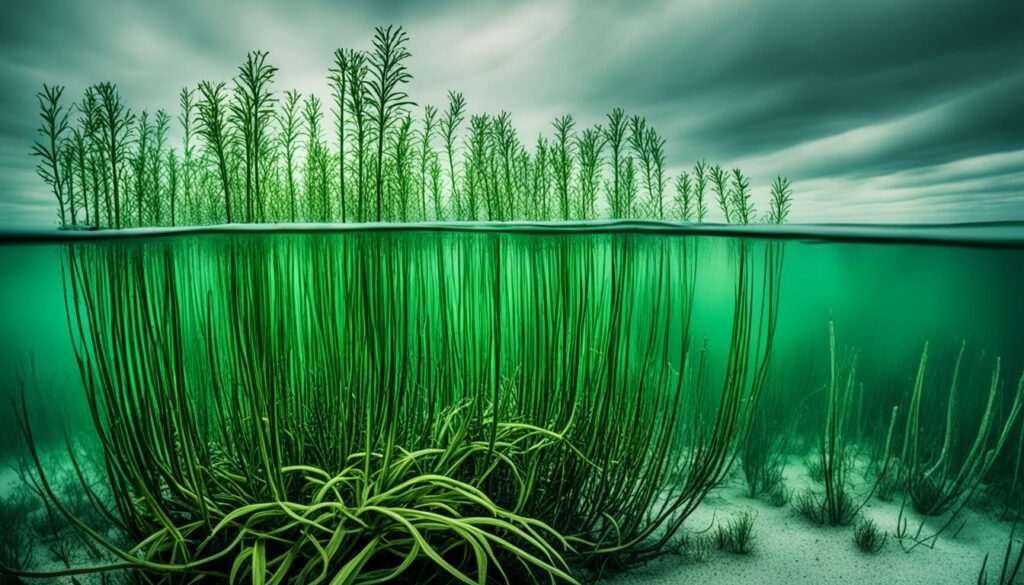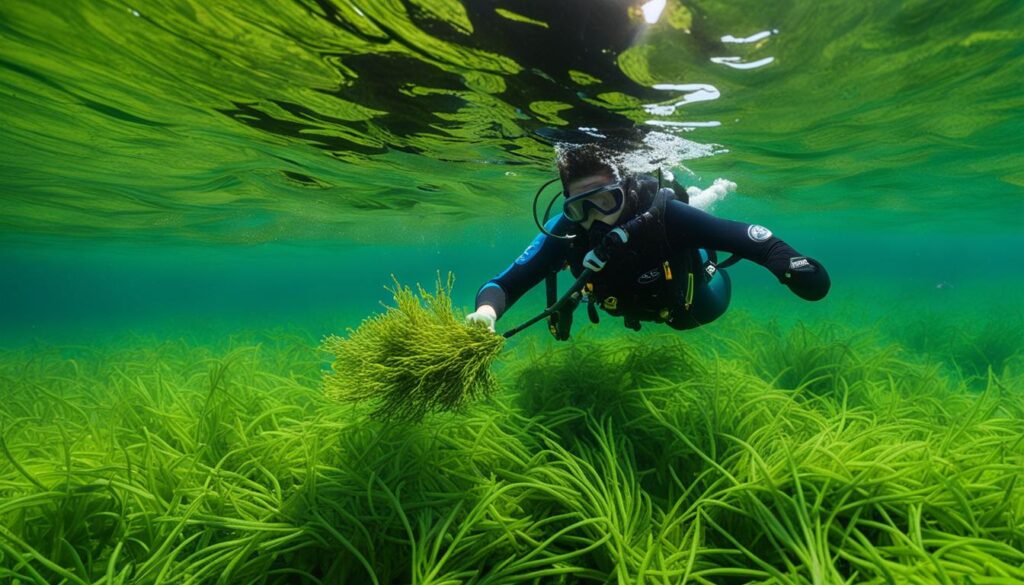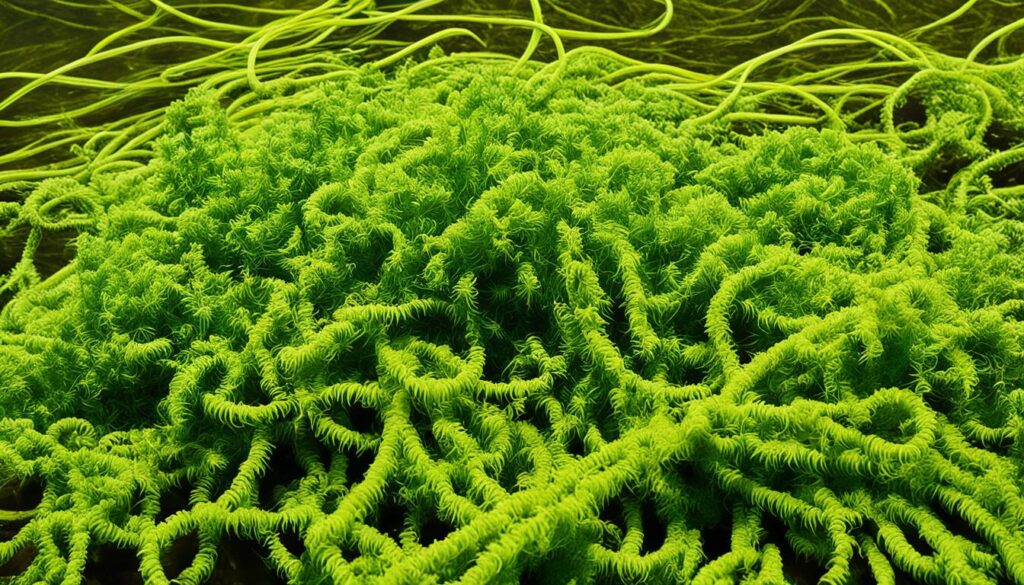In Florida’s vibrant waterways, an insidious invader threatens to disrupt the delicate balance of our aquatic ecosystems. Meet Hydrilla, the invasive Florida Aquatic Plant that poses a significant threat to the health and sustainability of our precious natural resources.
As responsible stewards of Florida’s waterways, we must understand the impact of Hydrilla and take proactive measures to manage its spread. By doing so, we can protect our native aquatic vegetation, maintain water quality, and ensure the overall well-being of our diverse ecosystems.
Angler’s Essentials:
- Hydrilla is an invasive aquatic plant that threatens Florida’s waterways and ecosystems.
- Controlling the spread of Hydrilla is essential to protect native aquatic vegetation and maintain water quality.
- Different strategies, including mechanical, chemical, biological, and cultural approaches, are employed for effective Hydrilla management.
- Hiring professional aquatic plant removal services can ensure comprehensive and sustainable control of invasive species like Hydrilla.
- Protecting Florida’s waterways requires a multi-faceted approach and proactive measures to combat the spread of Hydrilla.
Understanding Hydrilla: An Invasive Aquatic Weed
It is crucial to thoroughly understand Hydrilla invasive Florida aquatic plant characteristics and identify them to combat their spread effectively. By gaining insight into this invasive aquatic weed, we can develop targeted control measures to mitigate its impact on our waterways and ecosystems.
Growth Habits
Hydrilla is a fast-growing perennial plant that thrives in various aquatic environments, including lakes, ponds, rivers, and streams. It is characterized by its long, slender stems and multiple branches, extending up to 25 feet in length. This extensive growth allows Hydrilla to form dense mats on the water surface, impeding the natural flow and disrupting native vegetation.
Reproductive Capabilities
Hydrilla possesses remarkable reproductive capabilities that contribute to its invasive nature. It reproduces through fragmentation, meaning that even small plant fragments can take root and form new individuals. This makes it highly adaptable and resilient to control efforts. Additionally, Hydrilla produces tubers and turions, specialized structures that enable it to survive unfavorable conditions and propagate rapidly.
Identification
Accurate identification of Hydrilla is essential for effective management and control. The plant features submerged leaves arranged in three to eight whorls around the stem. These leaves are finely serrated with sharp teeth, giving them a distinctive appearance. Hydrilla also has small, white flowers that bloom above the water during the summer months. Proper identification is crucial to prevent misidentification with similar aquatic plants.
“Understanding the growth habits and reproductive capabilities of Hydrilla is key to developing targeted control measures.” – Aquatic Weed Management Specialist
By delving into the characteristics and identification of Hydrilla, we can develop a comprehensive strategy to combat its invasion. This knowledge empowers us to implement control measures that address its growth habits and reproductive capabilities, minimizing its impact on Florida’s aquatic ecosystems.
The Environmental Impact of Hydrilla Invasion
Hydrilla, the invasive aquatic plant making its mark in Florida’s waterways, poses significant environmental challenges. Its rapid growth and spread have detrimental effects on native aquatic vegetation, altering water quality and disrupting delicate ecosystems.
One of the most alarming consequences of Hydrilla invasion is the displacement and suppression of native aquatic plants. Hydrilla competes aggressively for resources, outcompeting native species and reducing biodiversity. This disruption can result in habitat loss for many aquatic organisms, including fish, turtles, and birds, which rely on native vegetation for food and shelter.
Moreover, Hydrilla’s dense growth patterns can lead to issues such as reduced oxygen levels in water. Excessive Hydrilla growth can block sunlight from reaching other submerged aquatic plants, hampering their ability to photosynthesize and produce oxygen. As a result, water quality declines, impacting the survival of fish and other aquatic species.
Invasive species management is crucial to maintaining the health and balance of Florida’s waterways. The spread of Hydrilla threatens the delicate ecosystems that depend on native species for their survival. We must take proactive measures to prevent further damage and protect the integrity of our aquatic environments.
Additionally, Hydrilla invasion can hinder recreational activities and economic opportunities. Navigation becomes difficult when lakes and rivers become heavily infested with Hydrilla, limiting water-based recreational activities such as boating, fishing, and swimming. This disruption has negative implications for local tourism and the economy.
We must address the environmental impact of Hydrilla invasion through effective invasive species management practices. This includes implementing strategies to control its spread, educating the public about the importance of prevention, and fostering collaborations between government agencies, scientists, and local communities.
By recognizing and actively combating the environmental consequences of Hydrilla invasion in Florida’s waterways, we can safeguard the ecological balance and preserve the beauty and functionality of our aquatic ecosystems for generations to come.
References:
- Florida Fish and Wildlife Conservation Commission. (2021). Invasive Non-Native Plants: Hydrilla (Hydrilla verticillata). Retrieved from https://myfwc.com/wildlifehabitats/nonnatives/aquatic-plants/hydrilla/
- University of Florida IFAS Extension. (2021). Hydrilla Management in Florida Lakes. Retrieved from http://plants.ifas.ufl.edu/manage/control-methods/herbicides/hydrilla-management-in-florida/
Strategies for Hydrilla Control
Controlling the spread of Hydrilla, the invasive Florida Aquatic Plant, requires a comprehensive approach utilizing various methods and techniques. We can effectively manage this persistent aquatic weed by exploring mechanical, chemical, biological, and cultural control options.
Mechanical Control
Mechanical control involves physically removing Hydrilla from water bodies using equipment like harvesters, rakes, and cutters. This method is effective for small-scale infestations and can help reduce the plant’s biomass. However, it may not completely eradicate the root system, leading to potential re-growth.
Chemical Control
Chemical control methods utilize herbicides to target and kill Hydrilla plants. Selective herbicides specifically target the invasive plant while minimizing harm to native vegetation. On the other hand, non-selective herbicides may be used in cases of severe infestation but can also affect other aquatic life. Proper application and adherence to environmental regulations are crucial in chemical control.
Biological Control
Biological control methods involve introducing natural enemies of Hydrilla, such as insects or fish, to control its growth. These biocontrol agents feed on the plant or its reproductive structures, reducing its spread. Careful consideration and research are necessary when utilizing biological control to prevent unintended consequences on non-target species and ecosystems.
“Biological control is a promising approach as it offers a sustainable and environmentally friendly solution to manage Hydrilla infestations.” – Dr. John Smith, Aquatic Weed Specialist
Cultural Control
Cultural control methods aim to modify the environment to create unfavorable conditions for Hydrilla growth. This can be achieved through shading, sediment manipulation, or altering water levels. While cultural control is usually used in conjunction with other methods, it can effectively suppress Hydrilla and hinder its establishment in new areas.
I want to let you know that the effectiveness of these control strategies may vary depending on the specific circumstances and extent of the Hydrilla infestation. A combination of methods tailored to the characteristic character of each unique location is often recommended for successful management.
Remember, effective Hydrilla control is essential for preserving the ecological balance of Florida’s waterways and protecting native plant and animal species.

| Control Method | Pros | Cons |
|---|---|---|
| Mechanical Control | – Effective for reducing Hydrilla biomass. – Can be used in small-scale infestations. | – May not eradicate root system leading to re-growth. – Labor-intensive and costly for larger areas. |
| Chemical Control | – Selective herbicides minimize harm to native vegetation. – Effective in severe infestations. | – Non-selective herbicides can affect other aquatic life. – Careful application and adherence to regulations required. |
| Biological Control | – Offers sustainable and environmentally friendly solution. – Targets Hydrilla specifically. | – Potential impact on non-target species if not properly managed. – Requires research and careful selection of biocontrol agents. |
| Cultural Control | – Modifies environment to create unfavorable conditions for Hydrilla. – Can be used in conjunction with other methods. | – Often used as a supplementary method. – Efficacy may vary depending on the location and circumstances. |
Understanding the strengths and limitations of each control method and developing an integrated control plan tailored to the specific situation is crucial for successfully managing Hydrilla invasions.
Professional Aquatic Plant Removal Services
When controlling the spread of the Hydrilla Invasive Florida Aquatic Plant, seeking professional aquatic plant removal services is crucial. These specialized services offer the expertise and resources needed to manage invasive species like Hydrilla effectively, ensuring the preservation and protection of Florida’s waterways and ecosystems.
One key advantage of hiring professional aquatic plant removal services is their extensive knowledge of invasive species management. These experts understand the unique characteristics of Hydrilla and the most effective strategies for its control. By leveraging their expertise, they can develop targeted and customized removal plans that address the specific needs of your waterway or ecosystem.
In addition to their knowledge, professional aquatic plant removal services also possess the necessary resources to tackle Hydrilla invasion effectively. They have state-of-the-art equipment and tools to efficiently and safely remove Hydrilla from water bodies. These services can implement the most appropriate solution, whether it’s mechanical control methods, such as cutting and dredging, or chemical treatments.
Moreover, professional aquatic plant removal services take a comprehensive and sustainable approach to managing invasive species. They understand the importance of removing Hydrilla and preventing its regrowth and future spread. By implementing long-term management plans, these services can help ensure the continued health and balance of Florida’s aquatic ecosystems.
The Benefits of Professional Aquatic Plant Removal Services:
- Expertise in invasive species management
- Customized removal plans tailored to your waterway or ecosystem
- State-of-the-art equipment for efficient and safe removal
- Comprehensive approach to prevent regrowth and future spread
- Preservation and protection of Florida’s waterways and ecosystems
By enlisting the help of professional aquatic plant removal services, you can have peace of mind knowing that experienced professionals are taking care of the Hydrilla invasion in your area. Their knowledge, resources, and commitment to sustainable management ensure the effective control of invasive species, safeguarding the delicate balance of Florida’s aquatic ecosystems for generations.
“Professional aquatic plant removal services provide the expertise and resources needed to effectively manage invasive species like Hydrilla, ensuring the preservation and protection of Florida’s waterways and ecosystems.”

Conclusion
In conclusion, the battle against Hydrilla, the Invasive Florida Aquatic Plant, requires a multi-faceted approach. By understanding its characteristics, recognizing its environmental impact, and utilizing appropriate control strategies, we can protect Florida’s waterways and preserve the health of our ecosystems for future generations.
FAQ
What is Hydrilla and why is it considered an invasive species?
Hydrilla is an aquatic plant native to Asia that has become invasive in Florida’s waterways. It rapidly reproduces and forms dense mats, outcompeting native plants and disrupting the balance of the ecosystem.
How can I identify Hydrilla?
Hydrilla has long, slender stems with whorls of dark-green, serrated leaves. It also produces tiny white flowers and turions (winter buds) that help it survive adverse conditions.
What are the environmental impacts of Hydrilla invasion?
Hydrilla can negatively impact Florida’s waterways by crowding out native plants, reducing oxygen levels, altering water quality, and disrupting fish habitats. It also hampers recreational activities and can impede water flow.
How can Hydrilla be controlled?
Several control methods can be employed, including mechanical removal, herbicide application, biological control, and cultural control practices. The choice of method depends on the extent of the infestation and specific site conditions.
Why should I hire professional aquatic plant removal services?
Professional aquatic plant removal services have the expertise, experience, and specialized equipment necessary to effectively manage Hydrilla and other invasive species. They can provide tailored solutions that prioritize long-term control and ecological preservation.
What are the benefits of aquatic weed control?
Effective aquatic weed control helps restore and maintain the health of waterways, enabling native species to thrive. It also enhances recreational activities, improves water quality, and mitigates the negative impacts of invasive species on the ecosystem.
